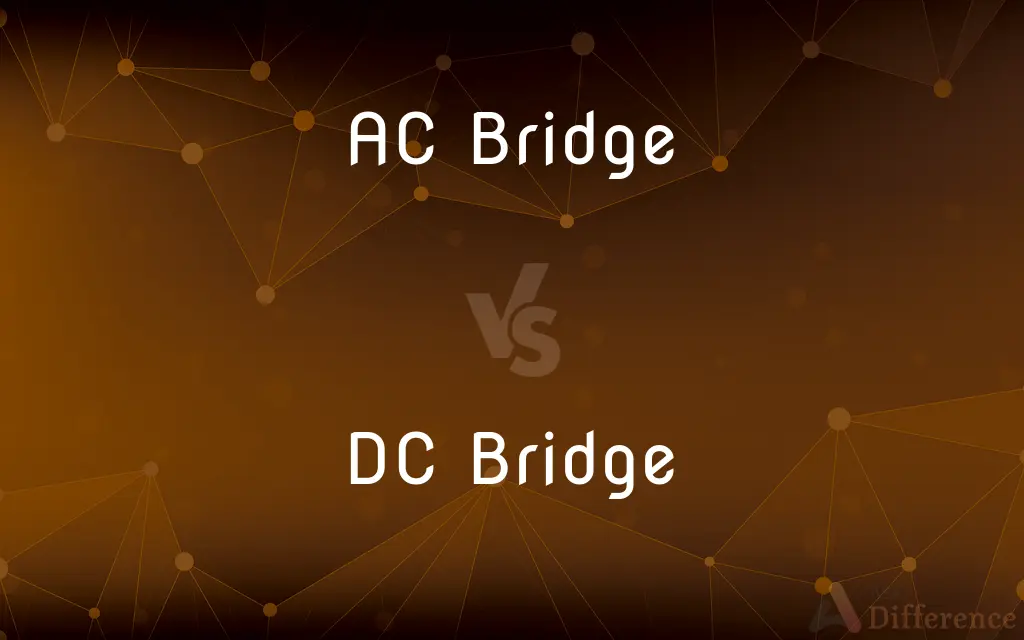AC Bridge vs. DC Bridge — What's the Difference?
By Tayyaba Rehman — Published on January 23, 2024
AC Bridges are used for measuring impedance in AC circuits, while DC Bridges are designed for measuring resistance in DC circuits.

Difference Between AC Bridge and DC Bridge
Table of Contents
ADVERTISEMENT
Key Differences
AC (Alternating Current) Bridges are used in electrical circuits where the current changes direction periodically. They are designed to measure unknown impedances (like capacitance, inductance, and resistance) in AC circuits. DC (Direct Current) Bridges, on the other hand, are used in circuits where current flows in only one direction and are primarily used for measuring unknown resistances in DC circuits.
An AC Bridge, such as the Wheatstone bridge, works by balancing two legs of a bridge circuit, one leg of which includes the unknown component. Its operation is based on the principle of null deflection, where the ratio of their impedances is equal, leading to no current flow through the bridge. A DC Bridge also functions on a similar principle but is used for precision measurement of resistances.
AC Bridges need to account for the phase and magnitude of impedances and often require complex calculations or adjustments for accurate measurement. DC Bridges are simpler in operation as they only deal with resistances.
Common examples of AC Bridges include the Maxwell Bridge, used for measuring inductance, and the Wien Bridge, for frequency measurement. For DC Bridges, the most common example is the Wheatstone Bridge, used extensively in laboratories for precise resistance measurements.
AC Bridges are crucial in AC circuit analysis, especially in radio frequency applications and telecommunications. DC Bridges are important in material testing, quality control, and laboratory research where precise resistance values are required.
ADVERTISEMENT
Comparison Chart
Application
Measuring impedance in AC circuits
Measuring resistance in DC circuits
Circuit Type
Alternating Current
Direct Current
Measurement Complexity
More complex, measures phase & magnitude
Simpler, measures only resistance
Common Examples
Maxwell Bridge, Wien Bridge
Wheatstone Bridge
Usage
Radio frequency, telecommunications
Material testing, laboratory research
Compare with Definitions
AC Bridge
Requires accounting for phase and magnitude.
When using an AC Bridge, it's important to consider both the phase angle and magnitude of impedances.
DC Bridge
Based on the principle of null deflection like AC Bridges.
The DC Bridge is adjusted until there's no current flow through the bridge for accurate measurement.
AC Bridge
Common in telecommunications.
AC Bridges are used in the telecom industry for impedance matching.
DC Bridge
Simpler operation compared to AC Bridges.
Using a DC Bridge is straightforward as it only involves resistance measurement.
AC Bridge
Used in complex circuit analyses.
AC Bridges are essential for analyzing radio frequency circuits.
DC Bridge
Primarily uses Wheatstone Bridge configuration.
The Wheatstone Bridge, a type of DC Bridge, is a common tool in our electrical testing lab.
AC Bridge
Operates on the principle of null deflection.
Adjusting the AC Bridge to achieve null deflection helps determine the unknown impedance accurately.
DC Bridge
A DC Bridge measures resistance in DC circuits.
To find the unknown resistance, we set up a DC Bridge.
AC Bridge
An AC Bridge measures impedance in AC circuits.
The engineer used an AC Bridge to measure the circuit's inductance.
DC Bridge
Widely used in material testing and quality control.
In the lab, we use a DC Bridge for precise resistance measurements of materials.
Common Curiosities
Can AC Bridges measure resistance like DC Bridges?
Yes, but AC Bridges are more commonly used for complex impedance measurements, not just resistance.
Can AC Bridges measure capacitance and inductance?
Yes, certain types of AC Bridges are designed to measure capacitance and inductance.
Are DC Bridges suitable for telecommunication applications?
DC Bridges are typically not used in telecommunications; AC Bridges are more suitable for this field.
Are DC Bridges used for high-frequency measurements?
No, DC Bridges are not suitable for high-frequency measurements; AC Bridges are used in those scenarios.
Can these bridges measure non-linear components?
These bridges are best suited for linear components. Non-linear components require different approaches.
Can DC Bridges be used with AC circuits?
No, DC Bridges are not suitable for AC circuits.
Is specialized training required to operate these bridges?
Basic knowledge of electrical principles is sufficient for DC Bridges, but AC Bridges might require more specialized understanding.
Is cost a significant factor in choosing between these bridges?
Yes, cost can be a factor, as AC Bridges can be more complex and expensive.
Can these bridges be used for on-field measurements?
DC Bridges are more portable and suited for field measurements, while AC Bridges are often more complex and used in lab settings.
Is a Wheatstone Bridge an AC or DC Bridge?
The Wheatstone Bridge is a type of DC Bridge.
Do AC Bridges require an external power source?
Yes, AC Bridges typically require an external AC power source.
How accurate are these bridge measurements?
Both types of bridges can offer high accuracy, but this depends on the quality of the bridge and the precision of the balancing.
Are these bridges affected by environmental factors?
Yes, factors like temperature and humidity can affect the accuracy of bridge measurements, especially for sensitive measurements.
Are there digital versions of these bridges?
Yes, there are modern digital versions of both AC and DC Bridges.
Do AC and DC Bridges have any safety concerns?
As with any electrical instrument, proper safety procedures should be followed to avoid electric shock or damage to the circuit.
Share Your Discovery

Previous Comparison
Daily Harvest vs. Hello Fresh
Next Comparison
Articles of Confederation vs. Declaration of IndependenceAuthor Spotlight
Written by
Tayyaba RehmanTayyaba Rehman is a distinguished writer, currently serving as a primary contributor to askdifference.com. As a researcher in semantics and etymology, Tayyaba's passion for the complexity of languages and their distinctions has found a perfect home on the platform. Tayyaba delves into the intricacies of language, distinguishing between commonly confused words and phrases, thereby providing clarity for readers worldwide.
















































